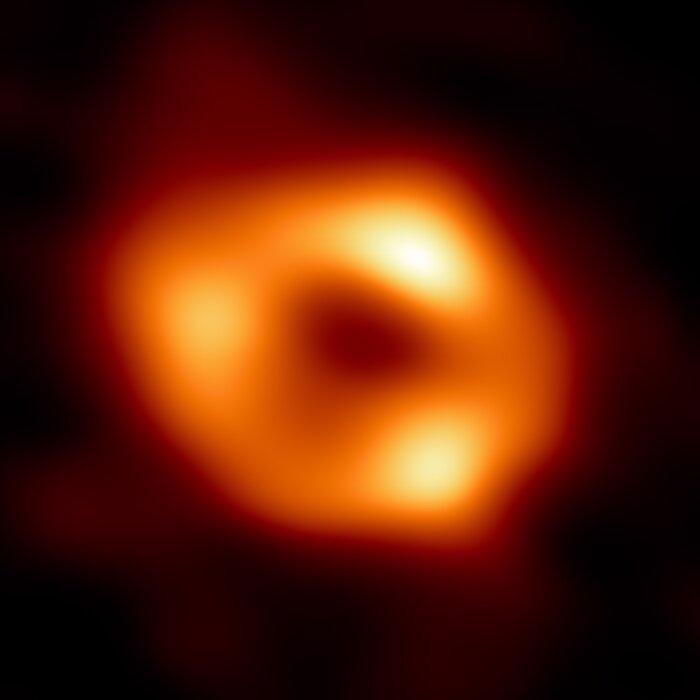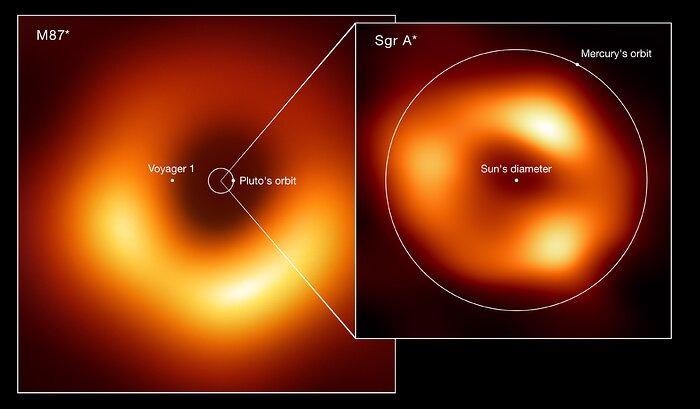If black holes emit no light and therefore cannot be seen, what is on show in the image of Sagittarius A*?

The first image of Sgr A* the supermassive black hole at the heart of the Milky Way. Image Credit: ESO/M. Kornmesser, EHT Collaboration
On Thursday May 12, the Event Horizon Telescope (EHT) collaboration released to the public the first image ever captured of the supermassive black hole at the heart of our galaxy — Sagittarius A* (Sgr A*).
As with the previous image of a supermassive black hole taken with the EHT — that of the black hole at the heart of the galaxy Messier 87 (M87) — Sgr A* appears as a glowing golden ring surrounded by inky blackness.
The EHT team’s results are discussed in a series of papers published in The Astrophysical Journal Letters.
Like all black holes, the object at the heart of the Milky Way — located 27,000 light-years from Earth — is surrounded by a surface that scientists call an event horizon. This is the point at which a black hole’s gravitational influence becomes so great that not even light is fast enough to escape.
This means that the event horizon of a black hole is the deepest into such a cosmic titan that astronomers can ever hope to see. This leads to the question; what is it we are seeing in the image of Sgr A*?
What is in the Image of Sagittarius A*?
Sgr A* is surrounded by dust and gas in what is known by astronomers as an accretion disc, which it very occasionally consumes. The glowing ring in the EHT image is this material with the black hole located in the center of this ring.
Despite closely resembling the image from M87, there are stark contrasts between the black hole at the heart of M87 and Sgr A*. Firstly, at 55 million light-years from Earth, M87’s supermassive black hole is much further away from Earth. M87 is not just over 1000 times as massive as our black hole—it also greedily consumes matter, blasting out powerful astrophysical jets as it does so.
The rate at which the Milky Way’s black hole Sgr A* “eats” is comparable to a human existing on a diet of one grain of rice every million years.
The closest distance at which this matter can orbit a supermassive black hole is known as the innermost stable orbit. At this point, gas and dust orbit the black hole at a considerable fraction of the speed of light thanks to the tremendous gravitational effect.

A size comparison between the first black hole directly imaged in M87 and the more diminutive black hole Sgr A*. Image Credit: EHT collaboration (acknowledgment: Lia Medeiros, xkcd)
This results in it being heated to incredible temperatures, causing it to glow. What we see in the image of Sgr A* is the shadow of the black hole against this material. The actual black hole — Sgr A* — is the blackness at the heart of this glowing golden ring of material.
The reason that the EHT managed to image the supermassive black hole of M87 before Sgr A*, despite the latter being much closer to Earth, is because of the relatively small size of our black hole.
Because the gas is moving at near the speed of light and Sgr A* is small, it takes only a short period of time for the gas and dust around this supermassive black hole to change incredibly quickly.
The innermost stable circular orbit for material around Sgr A* corresponds to a time of 4 minutes to 30 minutes, meaning that variations in the gas emission around the very center change on this time scale.
This is a much shorter time than a regular EHT observation window, which takes several hours. This ultimately required a massive network of telescopes coming together, and powerful computer programs to unite data from these instruments into one image.
Even though the image we see is almost exactly what astronomers would expect to see from such a black hole — and closely matches the black hole of M87 — this does not mean we have learned nothing new about the black hole at the heart of our galaxy.
What Do We Know About Sgr A* Now?
Sgr A*² was first discovered as a compact source of radio emissions located at the center of the Milky Way in the 1930s. Later observations would confirm the mass of this object as being 4.3 million times that of the sun.
However, what these further observations — mostly made by carefully monitoring the stars that orbit close to the galactic center, particularly the star S2 — did not do is confirm that this compact radio source is definitely a supermassive black hole.
An ESO video shows the size difference between the supermassive black hole at the heart of the Milky Way and that at the center of M87. Image Credit: ESO/M. Kornmesser, EHT Collaboration
Researchers had managed to eliminate other possibilities, such as a cluster of tightly packed stars, but true confirmation this is a black hole came only with the delivery of this image.
The EHT image reveals details of Sgr A* that we didn’t know previously, including the fact that the supermassive black hole looks at Earth almost face-on. Further, thanks to the observations that combine to make this image, we now also know that the black hole at the heart of the Milky Way is rotating.
Perhaps the most impressive thing about the image of Sgr A* is how close it is to what researchers believed it would be. The appearance of black holes and the effect they have on spacetime around them, which can be seen in the image, is a consequence of a theory developed over 100 years ago.
The EHT team spoke in a press conference, revealing this spectacular result and just how closely it resembles what is predicted by Einstein’s theory of general relativity.
The first direct imaging of Sgr A* unlocks a wealth of possibilities for astrophysicists going forward. Not only could further study of Sgr A* reveal secrets still hidden behind the event horizons of supermassive black holes, but it could prove to be the ultimate lab in which to test gravity and its effects.
References and Further Reading
Bower. G. C., [2022], “Focus on First Sgr A* Results from the Event Horizon Telescope,” Astrophysical Journal Letters, [https://iopscience.iop.org/journal/2041-8205/page/Focus_on_First_Sgr_A_Results]
Lea. R., [2022]., “Sagittarius A*: The Milky Way’s supermassive black hole,” Space.com, [https://www.space.com/sagittarius-a]
Disclaimer: The views expressed here are those of the author expressed in their private capacity and do not necessarily represent the views of AZoM.com Limited T/A AZoNetwork the owner and operator of this website. This disclaimer forms part of the Terms and conditions of use of this website.